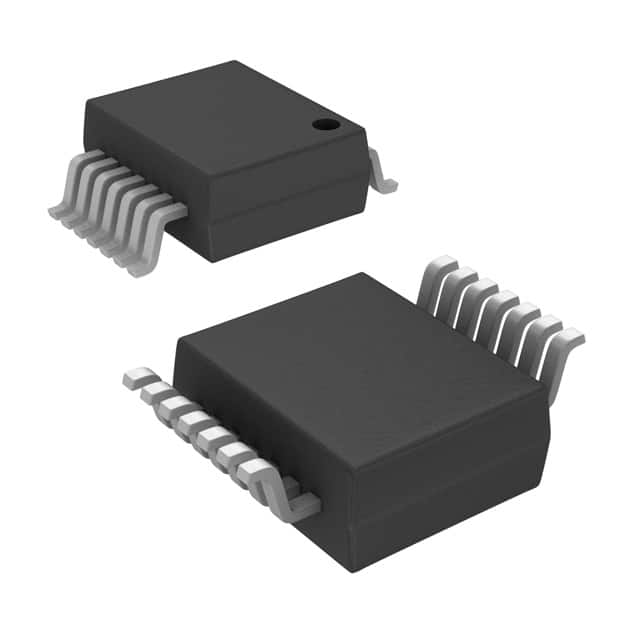SN74LV4052ADGVR
Product Overview
- Category: Integrated Circuit (IC)
- Use: Multiplexer/Demultiplexer
- Characteristics: Low-voltage, dual 4-channel analog multiplexer/demultiplexer
- Package: VSSOP (Very Small Outline Package)
- Essence: This IC is designed to provide a low-voltage solution for analog signal switching applications.
- Packaging/Quantity: Available in reels of 2500 units.
Specifications
- Supply Voltage Range: 1.65V to 5.5V
- Low ON-State Resistance: 45Ω (typical) at 3.3V supply voltage
- Low Input/Output Capacitance: 3pF (typical)
- Operating Temperature Range: -40°C to +85°C
- Input Signal Range: ±5V
- Channel-to-Channel Crosstalk: -70dB (typical) at 1MHz
Detailed Pin Configuration
The SN74LV4052ADGVR has a total of 16 pins, which are assigned as follows:
- INH - Inhibit Control Input
- S0 - Channel Selection Input
- S1 - Channel Selection Input
- E - Enable Control Input
- D0 - Analog/Digital Data Input or Output
- D1 - Analog/Digital Data Input or Output
- D2 - Analog/Digital Data Input or Output
- D3 - Analog/Digital Data Input or Output
- Y0 - Analog/Digital Data Output
- Y1 - Analog/Digital Data Output
- Y2 - Analog/Digital Data Output
- Y3 - Analog/Digital Data Output
- GND - Ground
- VCC - Positive Power Supply
- S2 - Channel Selection Input
- S3 - Channel Selection Input
Functional Features
- Dual 4-channel analog multiplexer/demultiplexer
- Low-voltage operation for compatibility with various systems
- Wide supply voltage range allows flexibility in system design
- Low ON-state resistance ensures minimal signal distortion
- Low input/output capacitance reduces loading effects on the signal
- Inhibit control input for disabling the device when not in use
- Enable control input for turning on/off the device as needed
Advantages and Disadvantages
Advantages
- Low-voltage operation makes it suitable for battery-powered devices
- Wide supply voltage range provides compatibility with different power sources
- Low ON-state resistance ensures accurate signal transmission
- Compact VSSOP package saves board space
- Inhibit and enable control inputs offer flexibility in system integration
Disadvantages
- Limited number of channels (4) may not be sufficient for certain applications requiring more inputs/outputs
- Not suitable for high-frequency applications due to limited bandwidth
Working Principles
The SN74LV4052ADGVR is a CMOS analog multiplexer/demultiplexer IC. It consists of two independent 4-channel multiplexers, which can be used together or separately. The channel selection inputs (S0-S3) determine which channel is connected to the common I/O terminal (Y0-Y3). The inhibit control input (INH) disables the device, preventing any signal from passing through. The enable control input (E) turns the device on/off.
When a specific channel is selected, the corresponding analog or digital data input (D0-D3) is connected to the output terminal (Y0-Y3). The low ON-state resistance ensures minimal signal distortion during the switching process. The low input/output capacitance reduces the loading effects on the signal, allowing for accurate transmission.
Detailed Application Field Plans
The SN74LV4052ADGVR is commonly used in various applications, including:
- Audio/Video Switching: It can be used to switch between different audio or video sources in multimedia systems, such as home theaters and audio mixers.
- Communication Systems: It enables the selection of different communication channels in devices like routers, modems, and telecommunication equipment.
- Test and Measurement Equipment: It allows for the multiplexing/demultiplexing of signals in test and measurement instruments, such as oscilloscopes and data acquisition systems.
- Industrial Control Systems: It facilitates signal routing in industrial control systems, such as PLCs (Programmable Logic Controllers) and automation equipment.
Detailed and Complete Alternative Models
- CD4052BE: CMOS Dual 4-Channel Analog Multiplexer/Demultiplexer
- ADG1402YRUZ: Low-Voltage, Dual SPST Analog Switch
- MAX4617ESE+: Low-Voltage, Dual SPDT Analog Switch
- TS5A23157DGSR: Low
Lista 10 Vanliga frågor och svar relaterade till tillämpningen av SN74LV4052ADGVR i tekniska lösningar
Sure! Here are 10 common questions and answers related to the application of SN74LV4052ADGVR:
Q: What is SN74LV4052ADGVR? A: SN74LV4052ADGVR is a multiplexer/demultiplexer IC (Integrated Circuit) that can be used in various technical solutions.
Q: What is the purpose of SN74LV4052ADGVR? A: The purpose of SN74LV4052ADGVR is to route multiple analog or digital signals through a single channel, allowing for efficient signal switching.
Q: What voltage levels does SN74LV4052ADGVR support? A: SN74LV4052ADGVR supports voltage levels ranging from 2V to 5.5V.
Q: How many channels does SN74LV4052ADGVR have? A: SN74LV4052ADGVR has two independent 4-channel multiplexers/demultiplexers, providing a total of 8 channels.
Q: Can SN74LV4052ADGVR handle both analog and digital signals? A: Yes, SN74LV4052ADGVR can handle both analog and digital signals, making it versatile for various applications.
Q: What is the maximum frequency at which SN74LV4052ADGVR can operate? A: SN74LV4052ADGVR can operate at a maximum frequency of 100MHz.
Q: Does SN74LV4052ADGVR require external power supply decoupling capacitors? A: Yes, it is recommended to use external power supply decoupling capacitors for stable operation of SN74LV4052ADGVR.
Q: Can SN74LV4052ADGVR be used in battery-powered applications? A: Yes, SN74LV4052ADGVR can be used in battery-powered applications as it supports a wide voltage range and has low power consumption.
Q: What is the package type of SN74LV4052ADGVR? A: SN74LV4052ADGVR comes in a small VSSOP (Very Small Outline Package) with 16 pins.
Q: Are there any application notes or reference designs available for SN74LV4052ADGVR? A: Yes, Texas Instruments provides application notes and reference designs that can help in implementing SN74LV4052ADGVR in various technical solutions.
Please note that these answers are general and may vary depending on the specific requirements and use cases. It is always recommended to refer to the datasheet and documentation provided by the manufacturer for accurate information.


